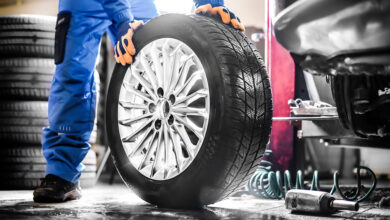The 10 Most Common Epoxy Mistakes
Epoxy adhesives are a valuable ‘chemical tool’ that can save the day in the shop, according to Permatex. Whether in a liquid or stick form, epoxies can create bonds that are strong enough to last for the life of the items repaired.
To ensure users get the best results, Permatex said to avoid these 10 common mistakes:
- Not cleaning or sufficiently preparing the surface
Like most any adhesive, epoxies work best when the mating surfaces are completely clean. Both surfaces should be free of grease, oil, dirt, and other contaminants, and the surfaces need to be dry as well.
Be aware that some cleaners can leave behind a residue that will interfere with the epoxy bond. Use solvents that won’t leave a residue such as isopropyl alcohol or acetone, but test these solvents first to check that they won’t damage a visible part of the repair item. Always wear solvent-resistant gloves, respirator, and eye protection when using acetone.
Those who can’t use a solvent should utilize a high-quality, residue-free industrial cleaner. When using any cleaner that’s not a solvent, be sure to thoroughly rinse with clean water and dry the surfaces completely.
- Choosing the wrong epoxy for the job
Epoxies come in a variety of formulas.
For a simple repair that won’t be subjected to high forces or stress, use a 60 second, general purpose epoxy.
Those in need of a higher strength bond can use a 30 minute, high-strength formula. It’ll take longer to set, but provide greater strength.
A five-minute epoxy splits the difference in terms of the required cure time and the strength of the bond.
If the repair will be regularly exposed to water, choose a waterproof epoxy-some epoxies will degrade over time if regularly exposed to water. Most epoxies are water-resistant compounds once cured; However, there are unique formulas made specifically for underwater repairs.
There are also specialty epoxies available for metals, high temperature applications, and plastics.
- Misjudging epoxy hardening time
Many DIYers use a five-minute epoxy and believe that it’ll harden in five minutes. The number of minutes in an epoxy’s name is not the time it takes to harden, but the amount of time that you have to mix it together, apply it, and bring the repair pieces together (known as the working time).
The time that it takes to harden to the point where the repair is safe to handle (referred to as the fixture time) is longer than the working time. The time when the repair has fully hardened is the cure time.
The bottom line is to check the package directions to learn how much time the epoxy needs for working time, achieving fixture strength, and full cure.
- Not holding parts together long enough for proper bonding
A five-minute epoxy may need 10 minutes to fully harden. You may want to use clamps, rubber bands, or weights to hold your pieces together, rather than try to hold them perfectly still for 10 minutes with one’s hands. Holding parts together by hand may result in a weaker cure due to hand fatigue that will not allow for constant pressure.
- Not kneading epoxy sticks enough or too much
Epoxy sticks are two-part formulas with an inner and outer layer of putty-like materials. To activate the bonding, the two parts must be thoroughly kneaded together. Those who do not knead the two parts into a completely uniform color will get pockets of epoxy that never fully cure.
On the other hand, if the two parts are kneaded for too long, the material will start to cure before application, losing its adhesive performance. The package instructions are the best place to get the timing right.
- Applying epoxy to a smooth surface
It’s difficult for any adhesive to form a strong bond if the surfaces are too smooth. Whenever possible, rough up the mating surfaces before giving the epoxy a surface that it can grip. Sandpaper or a mechanical tool can be used to score the surfaces, but don’t overdo it. Roughen the surfaces before cleaning prep. Clean away all the loose material raised by roughening.
- Mixing epoxy in an unsafe container
Epoxies heat up as they cure. Some can get hot enough to melt right through a disposable plastic cup. Choose a container that won’t melt or react with the epoxy.
Glass and ceramic are always a good bet, but don’t count on being able to get the residual hardened epoxy out. Pick a container that can be tossed when finished.
- Letting epoxy dry in direct sunlight
Many epoxies will yellow if allowed to cure in direct sunlight-always cure in the shade, if possible. Epoxy that is fully cured also will yellow if left in the sun for long periods of time. If that’s cosmetically unacceptable, look for another adhesive solution.
- Using an epoxy to make an extremely thin repair
If gluing a handle back on a ceramic mug, a really thin glue joint may be more important than the high strength that epoxies provide. Epoxies are extremely strong, but they do create a bit of material thickness between the repair pieces. For extremely thin repairs use a ‘super glue’ (cyanoacrylate-based adhesive).
- Not cleaning excess epoxy before it cures
Cured epoxy is really hard to get off most surfaces. In many cases, cured epoxy can only be removed mechanically or by scraping. Clean off any excess before it hardens.
Try not to let any epoxy cure where it’s not wanted. If uncured epoxy gets on the wrong parts, wipe it off with acetone (test acetone on the material surface first, and always wear solvent-resistant gloves, respirator, and eye protection when using acetone).
If the epoxy should harden where it’s not wanted, heating it with a hair dryer or professional heat gun can soften the epoxy to make it easier to remove. This step may not help with high temperature epoxies.
If uncured epoxy gets on skin, wipe it off with a clean cloth or paper towel and then use a professional-strength hand cleaner and lots of water to get it off. Be patient, it may take some time to remove.



